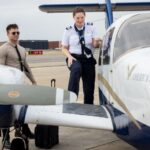By Mike Forth
The holiday season is just around the corner, and it can be one of the best times of the year to fly. Round up your family and friends, jump into an airplane, and you’re off on an adventure during the most joyous time of the year.
Remember though, there’s more to flying during the holidays than jumping into an airplane and rocketing into a blue sky. You might be flying into more than you bargained for if you allow your excitement for holiday travel to overtake your due diligence. The holidays generate so much excitement, joy, and pleasure that we may get caught up in our anticipation and overlook some of the essential factors of flight.
During the holidays, while our minds shift to the wonders of the season, the weather is often shifting too. These changes can go unnoticed, and if caught unaware, you might see the signs too late. To ensure you don’t overlook these subtle changes, remember to do your flight review before taking off. Also, make sure to perform your preflight planning to reduce the risk of unexpected problems during flight. This includes your weather briefing as well as brushing up on your currency and proficiency.
We all know we have to check the weather, but sometimes we may find ourselves just going through the motions. Anytime you’re checking the weather for a cross-country trip, make sure to get all the information you can about your return home as well as your immediate trip. While it can be tempting to leave on a trip while the weather is great, it can be dangerous if you have no idea what’s in store over the next few days or weeks.
Heading out for the holidays can mean a longer than usual stay at your destination, and though you can’t always predict what the weather will be like when you head home, you can prepare for the unexpected. Plan to stay a little longer if necessary and have an alternate route prepared if the weather changes on your departure date or along the way. Be flexible and have the courage to say “it’s a no go.” It’s better to make the call and postpone the flight than to encounter weather-related problems during flight.
Other factors relevant to flying safely in all seasons (including the holiday season) are currency and proficiency. The truth is, your currency and proficiency begin to erode the day after your checkride, and if you’re not careful, you could find yourself in a situation that would have been totally avoidable had you kept your skills up-to-date.
Much carelessness is due to “armchair flying syndrome.” How many times have we, as a group, suggested (from the comfort of our favorite chairs) that we know the reason for an incident just minutes after the first report and then think no more of it, even though we may not have been behind the controls for months? We convince ourselves that such an incident could never happen to us – that we wouldn’t have made that mistake or done it that way. We often think to ourselves, “I’m current, I’m proficient.”
I once rode along on a biennial flight review (BFR) being conducted in a Cessna 421 Golden Eagle. The pilot flew the airplane at least once a week, sometimes more. Everything, as you might expect, was perfect: maneuvers, engine outs, stalls, and approaches. Everything, that is, until we reached short final. The pilot had executed a flawless, single-engine NDB approach under the hood. As he pulled the power back on short final, an ear-splitting horn started to scream, but we continued on with no sign of recognition from the pilot. The instructor conducting the review asked him if he was ready to land. He responded, saying, “Pre-landing check complete.” He made no move to either silence the horn or check his panel.
The instructor took the controls and asked the pilot to relax, take a look around, and let him know if we were indeed ready to land. Of course, as soon as the responsibility of flying was taken away, he noticed the three dead gear lights, and only then did he hear the horn. Once safely on the ground, the pilot admitted that he had not read the entire pre-landing checklist. What really startled him was the fact that he did not hear the warning horn. He couldn’t believe such a thing was possible.
There’s only one way to make every season a great time to fly, and that’s to think and fly like a professional. Have a currency schedule and stick to it, and factor it into your flying schedule year in and year out.
Understand that demonstrating professionalism as a pilot, no matter the certificate you carry, relies on the continuous dedication to training and staying current. Currency and proficiency are not limited to flying the plane. They also encompass being up to speed with rules and regulations (which are constantly changing) and truly understanding weather reports. This preparation will give you the confidence to make the right decisions. Without it, it’s all guess work.
So, avoid the rush and make every season a season to fly. Schedule some time with your instructor, take a refresher course, read through the FARs, and get the answers to those lingering questions from a professional. Then you’ll be sufficiently prepared to really enjoy a holiday adventure with friends and family.
Blue skies and light winds! Have a wonderful holiday season.










